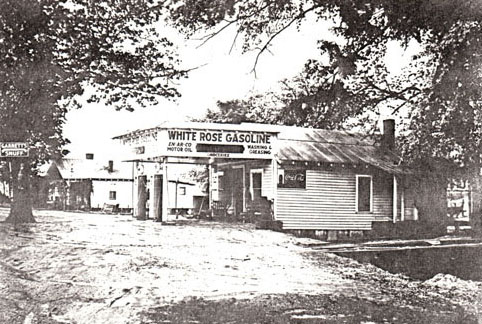
Thomas Neutry McCoy's Service
Station
Main Street, Walnut, MS -
mid 1930's

Thomas Neutry McCoy's Service
Station
Main Street, Walnut, MS -
mid 1930's
Contents:
History
of Walnut
Education
in Walnut
Sorghum
Making -featuring a
picture of the Alsup
family
Old
Pictures of Downtown Walnut
Mr.
Butler's Class at Walnut -1913
Walnut
High School Graduates - 1949
Wright School
Growing
Up in North Tippah
My
memories of Walnut and the Wilbanks family
|
Here is a partial list of graves located in the destroyed cemetery. CARTWRIGHT, W. C. "Dick" (Obit. SENTINEL Feb. 11, 1904)
died
last Wednesday, age 54 years / leaves wife and children / buried at
Mitchell
Cemetery. |
History
of Walnut, Mississippi
Located in North Tippah, 3 miles south of the Tennessee line near the intersection of Hwy 15 and Hwy 72, Walnut continues to be a thriving town. The town was established on November 6, 1872, on land purchased by Henry Hopkins from the Chicakasaw Indian Cession in 1836. Originally the town was called Hopkins and changed to Walnut in 1876. Walnut originated as a stopping point for the railroad that ran from Middleton to Pontotoc. The train needed both wood and water to run and would stop near Walnut for water on it's trips between the towns. The name changed after a barrel of whiskey was accidently dropped at Hopkins, instead of Hopkinsville another village about a mile to the south. The conductor had to back the train up one mile to Hopkinsville to deliver the Whiskey barrel to the store owned by Silas and John Hopkins. After arriving back in Hopkins and hearing the complaint Mr. Bob Shannon suggested that Hopkins be called Walnut after a grove of Walnut trees located near the town to stop any confusion. This was agreed upon and from that day forward the town was called Walnut. A charter for the town was recorded in the office of the Secretary of State and State Library on July 10, 1936.
Although Walnut has changed over the years and
moved a little it still remains a thriving town with over 700
residents.
Currently, the town has all the modern conveniences; a bank, a library,
city hall, a school k-12, a grocery store, a video store and tanning
salon,
a drug store, a hardware store, a public swimming pool, a park, a
few restaurants, a couple dollar stores and an antique store. The
furniture and elevator manufacturing industry provides jobs for it's
residents
and some even commute to Memphis to work. The newly four-laned
Hwy.
72, one of the few in the county, continues to add to it's growth.
Education
in Walnut
from Andrew Brown's History of
Tippah County, Mississippi
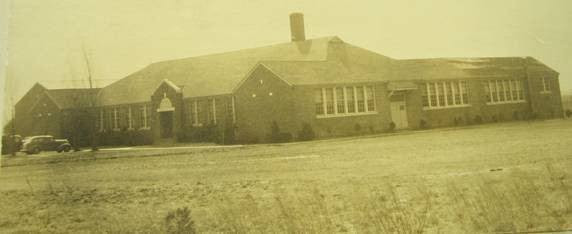
Walnut's New School - 1930's
After the school burned seventeen
acres of land
was purchased from John
N. Quinn and a new brick school was built in 1933. It
contained
9 classrooms, library, studyhall, lunchroom, storage room, auditorium
which
seated 400, an office and toilets. This building is still in use, and
over
the years it has grown to include newer buildings for the elementary
school,
gym and cafeteria.
Today, Walnut High School is a level 5 school with 290 students.
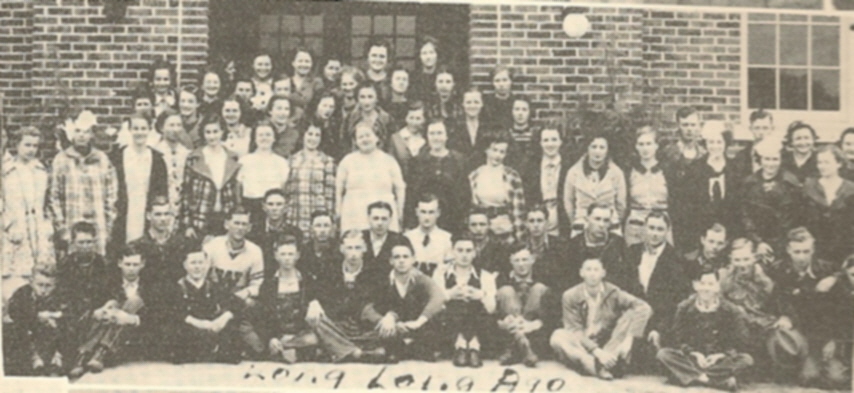 Found in the 1950 Yearbook, and written at the bottom Long, Long Ago. So I'm guessing late 1930's since the school opened then in the new location. If you have a clue or know anyone let me know. |
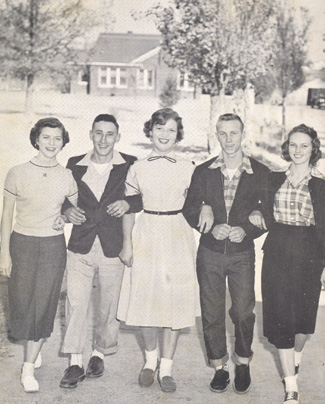 1954 Class Officers Walnut High School |
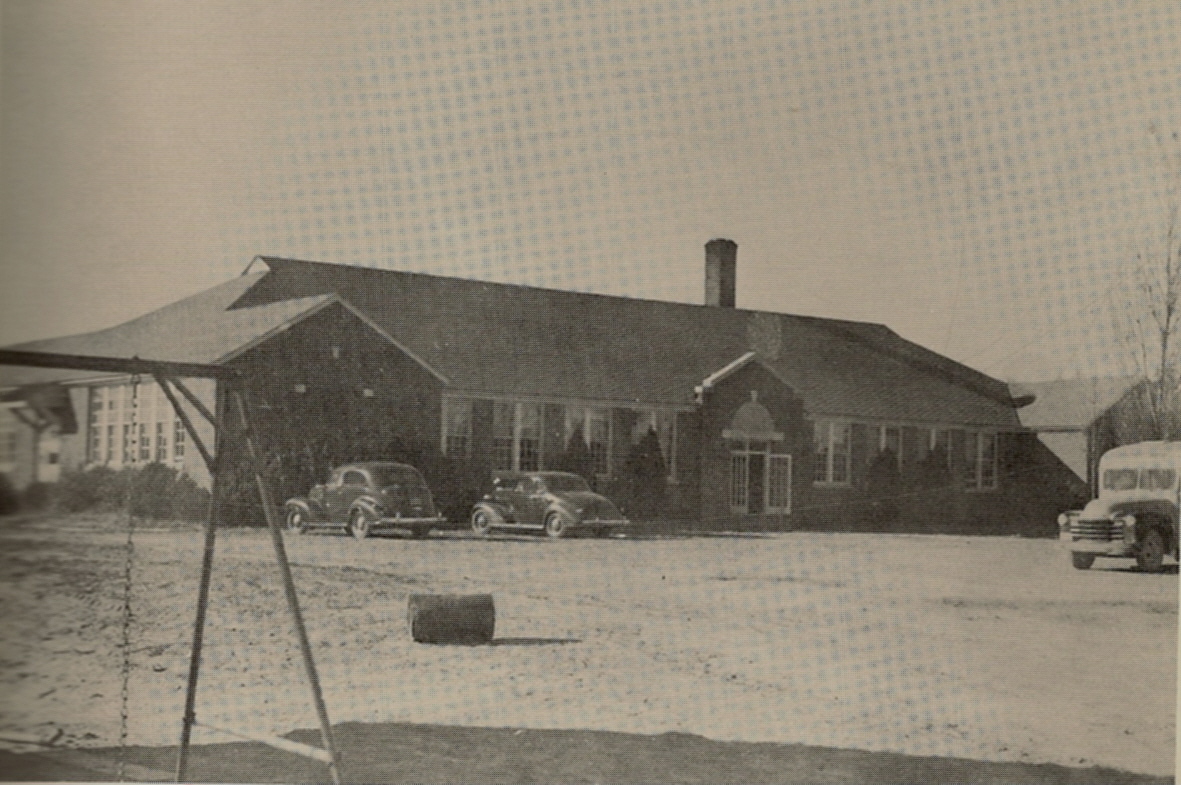 Picture of Walnut High School from the 1950 Yearbook |
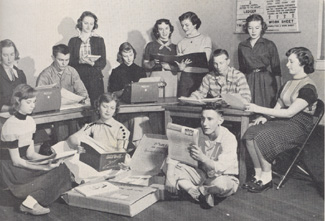 1954
Annual Staff - Walnut High School
|
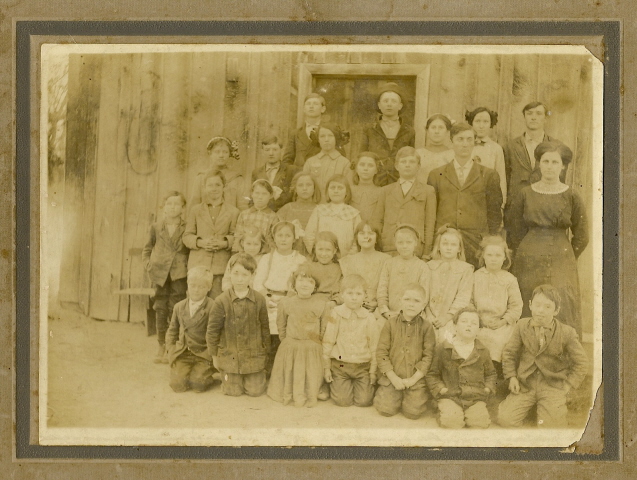
Wright
School -circa 1912
Identified
in the Picture are:
Luva Wright, Leroy Luker, Bryan Wright, Vonce Thornton, Clyde Thorton,
Mary Paseur, and Lee Thorton. Mary
Pasuer and Lee Thorton are standing next to the gentleman
teacher. If you can identify any others please contact me.
GROWING
UP IN NORTH TIPPAH, MISSISSIPPI
An account
written by Guy Manning Rowland,
the son of Huey Isaac and Ida Jewel Garrett Rowland.
I was born in 1924,
and delivered by Dr.
E. J. Green of Chalybeate, MS. I was the 6th of seven children
born
of the marriage of Ida Jewel Garrett of Chalybeate, MS and Huey Isaac
Rowland.
They were married on November 12, 1912. Both
families were of pioneer stock and they were
among the early settlers of Tippah County and North Central
Mississippi.
At the time of their marriage my father was a prosperous young Rural
mail
Carrier and land owner, in the small town of Walnut. Dad had a
long
courtship with my beautiful and popular mother, but by flamboyant and
persistent
courtship he finally won her over.
His primary mode of
transportation during the
courtship was a beautiful matching pair of White Horses and a classy
single
seated buggy.
We lived in a modest L shaped clapboard house
about 150 yards west of the Gulf Mobile and Northern Railroad on the
Northwestern
corner of the old Highway 15 and old Highway 72 junction, which was in
the center of the business district of the town.
My earliest memories of our home place was its
location in the very middle of everything that happened in
Walnut.
There was always something going on just outside of our front
door.
In those years all commercial activity consisted of the coming and
going
of loud trucks or two or four team wagons, loaded with cotton,
fertilizer,
logs or household effects. It was quite exciting to sit or lay in
our front yard and watch the activity, going about, on the two Highways
in our front yard. Add to
this the goings on associated with the
large family of children in the Rowland family and the many friends
that
filtered in and out of our house throughout the days, seasons and years.
Let me digress at this point
and explain.
In the second year of my life our lovely and popular mother died of
blood
poisoning shortly after the birth of my younger brother Jewel
Rowland.
This, of course, greatly affected the routine and order in their large
family. Dad not only was faced with the problem of continuing to
earn a living for this large family, but also had to provide for the
orderly
operation of his extended family in his absence. One must not
forget
that he had an infant son without a mother to nourish him and love him
as only a mother can do.
Dad had a sister, Montie
Rowland Frederick, who
lived across the Rail Road track, that agreed to take the baby Jewel
and
nourish him and love him along with her own four children, the youngest
of which was only two years old. Dad eventually was prosperous
enough
that he was able to hire a succession of house mothers and cooks and
maids
to keep us going.
Eventually Jewel grew enough
that Aunt Montie
was able to return him to our family, and with the help of those hired,
the family and by the grace of God and oldest sister Ruth Rowland, we
were
able to hold the family together.
All this time Dad was trying to hold his family
together, without a loving wife and mother, he had the good sense to
think
of the future without a wife. He had previously dated a lovely
young
lady from nearby Middleton, TN, in his earlier years. Dad finally
took the "Bull by the Horns" and wrote to her asking if he could call
on
her again. (Note this letter is in my possession)
Apparently she accepted his
offer and if she did
not know of his dilemma previously, she was soon no doubt made aware of
it. Can you imagine an individual dating a former acquaintance
with
six children, the youngest of which was about three and one half, a man
looking for a mother to raise this motley crew?
Well she apparently understood his situation and
knowingly agreed to see him again. What a salesman my father must
have been. He also must have been a little desperate. We
have
no way of knowing what he promised Annie Laurie Wilson, but on--------
he and Annie were married by C. M. Wilbanks in Corinth
Mississippi.
She came into this circus all the while realizing the older sons and
daughters
remembered and loved our real mother. I cannot remember my real
mother
and Jewel's and my step mother Annie was the only mother we knew and
loved.
She adopted us as we adopted her. Our neighbors accepted her with
open arms. She was truly a Godsend to our family and to the town
of Walnut.
Can you imagine the relief when
the town realized
that the Rowland clan of unsupervised urchins were now under the
supervision
of a "real" mother, instead of housemothers and hired help. What
a relief to the town and to us, because it wasn't long before she had
us
all under control.
My early memories relate,
basically, to our home
and the three acres of land on which it occupied. The home place,
including most of the land on which the main part of Walnut now
occupies,
was purchased from Dr. Marsh, with the understanding that Dad would
allow his widow to live in her "Log
Cabin" for the balance of her life. This Dad agreed to, and I
remember
her living in that cabin which was located just South of our
home.
It was located exactly where the Bank of Walnut was located across the
street from our home. It is now the City Hall.
When old Highway 72 was built
through Walnut,
both our home and the Marsh log cabin were left on a high bank.
Dad
had steps built up to our house but us youngsters had to help build the
dirt steps up to the Marsh cabin. (Note, old Highway 72 is the
current
road to Chalybeate)
At this time Mrs Marsh was gone and the hired
help lived in the cabin. Later, when Dad decided to develop this
area, he moved the log cabin Southwest about 100 yards under a large
Mulberry
tree.
This was the pasture area and
was located about
where the Arlie Doyle Warehouse is now located. The old cabin was then
used as a hay and feed storage barn and later the back portion was used
as a stable. It was in this location that I milked the cows in
bad
weather as a teenager.
Our home started out as a two
room dog trot at
its present location. To this was added an "L" containing a
dining
room and kitchen with a tin roof porch on the back of the entire
house.
Dad enclosed the dogtrot and made it the living room.
He then added a small bedroom
under part of this
tin roofed back porch on the Eastern side. I can remember
sleeping
with Dad in this small room before he remarried. What a great
place
to sleep with the rain falling on the tin roof. Later the tin
roofed
back porch and bedroom were removed and a large dining room, another
back
porch and two bedrooms were added. Later a bathroom was also
added
to this addition on the new back porch.
Over the years our Dad built the following
buildings
to the rear of the house.
1. The well house- made of brick, this building housed our deep well and a 500 gallon water tank. Initially we pumped the water manually using a hand pump. Later a one cylinder gas powered pump did the chore for us. About 1935 we got electricity and an electric motor pump was installed.
Each day, we boys were
assigned the duty of turning
on the pump or starting the gas engine, etc., until sufficient water
and
pressure was available to last the day. Dad did not like it when
we failed to perform our duties which caused us to run out of water
pressure
and water.
One or another of the above
systems was used until
H. E. Wilbanks watched helplessly as his planeing mill burned to the
ground,
because no water was available in quantity to fight the fire..
This
happened in the early forties. To keep this from happening again
Mr. Wilbanks dug a deep well and purchased a water tower.
Eventually
all the town residences were given access to this water supply.
This
system was later sold to the Town of Walnut, expanded and improved.
2. The smoke house- made of wide boards nailed up and down, with a dirt floor. This is where our Dad cured his meat. While I never remember him curing meats with fire and smoke, I know he cured the bacon and hams with salt, in the salt box. With such a large family a smoke house was a necessity to keep meat edible over the months. As a young boy I used this building to nail up my basketball goal which provided me and my friends with many good games. I also used the building when it was time to kill the Thanksgiving turkey. I simply tied its feet, hung it to a nail, held its head and chopped the head off with a hatchet. While crude it was very effective. Our Dad always used to order fresh Gulf Coast Oysters each year, because he love oyster dressing.
Our Dad was constantly given Water Melons by many of his mail customers. We literally had to store many of these as there were too many to eat at on time. The mail route patrons were great to us as the graciously kept us supplied with fresh vegetables from their gardens and fresh or cured meat from their barnyards throughout the year. What great neighbors they were. Many of them were, I learned too late in life, relatives of ours, some close some distant.
"NEITHER RAIN NOR SLEET NOR DEAD OF NIGHT SHALL
KEEP......".etc.
3. A two car garage- was constructed of tin. It was built to hold two of Dad's several vehicles that he used to deliver the mail on his forty odd mile route. In those years none of the route was done on a paved road, paved roads were reserved for cities or the state highways in rich counties. Very few of the 40 miles was even graveled. Most of it was sand, clay or a mixture of these. In rainy weather and nearly all the winter, the road were all but impassable.
Daddy used to keep at least
two A Model Fords,
a high wheel 1934 V8 (this was in the 40's). In the 30's he had
only
two Model A's, plus an enclosed one horse surry, which he kept in a
small
stall (garage) across old Highway 15, east of the house. He also
kept his horse in this stall in bad weather. Once we went to
hitch
up his horse to the Surry, so he could began his mail route, only to
discover
the horse was missing. Things were not good for a while until he
later discovered that Mr. Charlie Mohundro had borrowed the horse to go
home on the night before. Mr. Mohundro lived about three miles
Southwest
on Hurricane Creek (we pronounced it Hurikan).
At that period of time people felt comfortable
to helping themselves to other peoples property without permission,
since
real dishonesty was very rare. The missing horse event was spoken
of by the Elders of the community for many years.
Now Daddy's garage was just about the perfect size
for two Model A's but as the size of automobiles increased in size
during
the early 40's, the rear end of them constantly protruded from the
garage.
It served its purpose however, which was basically to protect the
windshield
and the cooling system during freezing weather.
As I recall we often had to drain all of his automobiles
during cold spells, as anti-freeze was not in common usage at that
time.
Why, you may ask, did Daddy keep two Model A's?, and why did he make
annual
trips to Memphis to purchase good used ones? The answer was of
course
that the mail had to be delivered rain or shine, and if he had a
breakdown,
not that uncommon back then, or if one vehicle was in the shop for
repairs,
or if he ran off the road into a ditch, easy to do back then also, then
he always had a back up vehicle. Usually if he became stuck in a
ditch or bottom, he was able to get help from local families to pull
him
out or he was able to secure his three foot jack, tie a rope around a
tree
or fence post and lever or jack the car out. If this was not
possible
that day he would walk or hitch a ride back to town, pick up his spare
and complete the route.
THE SUNDAY AUTOMOBILE
Daddy also kept a "Sunday"
car, the first nice
one being a 1935 Dodge, which was the first car equipped with hydraulic
brakes. These new and improved brakes caused a wreck one
day.
All of us children had begged and talked Daddy into letting us drive
the
Dodge to the 1938 Tippah County Fair in Ripley. My older brother
C. Grambrell Rowland was the designated driver. Grambrell was the
family strong man and daredevil. All of us were in the Dodge and
in great spirits headed South on the graveled Highway 15.
Just South of Tipplersville a stalled flatbed truck
suddenly appeared dead smack in the middle of the road ahead, as we
rounded
a curve on an up-grade. Gambrell (one of my older brothers)
slammed
on the brakes, he was used to the old style mechanical brakes and he
was
very strong. The brakes locked up tight and we of course slid
directly
into the flatbed. Had Gambrell only been more used to the new
brakes,
he could have easily slowed enough to go around the truck on the left
side.
As it was the car was damaged beyond repair, but surprisingly, and with
the Grace of God, no one was hurt, except for a sore nose and
Gambrell's
pride. This, I might add was a considerable time before seat
belts.
Daddy then traded the wrecked 35 Dodge for a 1938 model.
The last "Sunday" car purchased by Huey Isaac
Rowland
was a 1940 Lincoln Zephyr!!! Wow, what a car. We were the
envy
of every family in Walnut if not the whole of Tippah County.
4. The Cooks house- was built of clapboard
and painted white in keeping with the home place. We had various
domestic helpers, what with so many children in the household and
because
of the good and steady income our father was able to provide, for a
long
as I can remember. The first Cook/housekeeper that I remember was
Ossie. She lived in the old Marsh log cabin across the road for
many
years. The came Susie Lee Spight, who began working for our
family
as a young girl. She worked in the household off and on until
both
Mama and Daddy passed away. (Note H. I. Rowland died in 1950) (The
Spight
name is an old Tippah County name.)
Most of the time Susie Lee lived in the Cooks House,
which was a large one room building with two closets in the rear.
This was before the addition of indoor toilets so everyone on the
premises
used the two holer in the rear of the home. It was not until the
late 1930's that the indoor bathroom was installed. Susie was an
important part of the family and often
kept us when our parents went to Church functions or visited with
neighbors
or relations.
The Family Churches
The family went to church at
Harmony until the
mid to late 1930's when Mother and Dad became part of a splinter group
that broke away and formed a new church located at the intersection of
New Highway 15 and old Highway 72. Harmony Baptist Church was
about
one and one half miles North of Town and many people felt that Walnut
deserved
a Church of its own. Daddy donated the land to the new Walnut
Baptist
Church, and has a stained glass window for his devotion as a Deacon.
Over the years we had a number of different cooks
and we children loved them all, but Susie Lee was our favorite and when
she died, we all attended her funeral at the Sand Hill Church.
(Note,
Sand Hill was the name of the voting precinct in N. Tippah County
untill
being replaced by Walnut.)
5. The chicken house- was built of rough planking and contained both a storage room and a chicken roost and egg nests. Mama was a great believer in keeping chickens. We often accused her of treating her chicks better than her children. She even baked cornbread for the chickens on occasion, to give them a change from their usual diet of scraps, corn and commercial mixes. She apparently had a standing order with Sears, Roebuck & Co., to ship her at least 100 baby chicks every spring by mail. Daddy usually delivered these to her with his usual "Here's you durn chicks!", brought on by the fact that at least 30 to 40 of his mail route patrons had received the same shipment over a few week period. Dad had to personally drive up to each home on his route to deliver the live chicks in person.
The delivery of the Spring Chicks was a ritual along with the delivery of the heavy Sears Catalogs several times each year. It is no wonder that Daddy built up such a "love hate" relationship with the mail order giants. He didn't complain too much when this writer went to work for the Sears giant in 1951 and continued until they closed the catalogue business in the 1990's.
Daddy even purchased rebuilt engines, tires and other items from Sears during his mail carrier days. In an attempt to make wash up easier the boys of the family built their own outdoor shower between the house and the tin garage. We could use it only during the summer months because no hot water was available there. This outdoor shower was installed before the installation of the indoor toilet.
According to Uncle Guy Manning Rowland, living North of the Rowland home, in the 1930's to 40's, were the following families;
1. Verna and Annie Lee Boyd Luna
2. Howard Luna and wife ? Davis.
3. Daniel Craig and wife. He was the brother
of Troy R. Craig
4. The lumber yard of Everette Wilbanks was next,
where the old swimming pool was located.
5. The home of H. Everette Wilbanks
6. The Lee Smith family, bought land from H. E.
Wilbanks.
7. The Hudson family, the Hudson's probably bought
the home from the Smith's.
8. The Jack Wilbanks home.
9. The Leroy and Ruth Rowland Hughes family.
10. The Elbert Wilbanks family, he was the 1st
cousin of H. E. Wilbanks
11. The J. Neely Wilbanks family, he was the
father
of H. Everette Wilbanks.
The only child of Henry
Everett and Lassie Wilbanks
was, Jack Wilbanks. H. Everett Wilbanks, became a successful
lumberman
and cotton gin operator in Walnut. Their son Jack Wilbanks,
married
Mildred Thompson, their son is Phillip Wilbanks. Mildred was the
daughter
of Walter and Effie Thompson of Middleton. They managed and owned
the Bus Station Cafe in Walnut.
My father, Leroy Hughes married Ruth Rowland the
eldest child of Huey Isaac Rowland. He lived with the H. Everett
and Lassie Wilbanks family, as a young man, and he became, as an older
brother to Jack Wilbanks.
My father, Leroy Hughes and my mother, Ruth Rowland
Hughes, lived next door to Jack and Mildred Wilbanks, on the ridge
line,
north of the H. I. Rowland and H. E. Wilbanks homes, on old Highway 15,
South of New Highway 72, and across the street from, and facing East
toward
the railroad.
Henry Everett Wilbanks and Lassie Hobson Wilbanks
(I grew up thanking of them as my grand father and grand mother, I
called
her Mother Lassie and, H. E. Wilbanks, I called Dad Everett), lived on
property that had a large lumber yard just to the South. This also was
the location of the city water supply and water tower, and, in the
1960's,
the city swimming pool. According to the book, "Tippah County
Heritage,
Vol I"; In 1938, Mr. and Mrs. H. E. Wilbanks had the first
deep well dug and a water tank installed. This tank was located
where
the swimming pool is now. It had a capacity of 30,000
gallons. This water system was for their own private use
to serve as a prevention against fires in their businesses. After
some time other people wanted to use the water and were allowed to do
son
at a flat rate of $1.50 per month. Across the street, on the Railroad
tracks, was
the Cotton Gin, owned by H. E. Wilbanks, where I would play as a young
child. As South of the Gin was the stockyard.
"Mother" Lassie (Hobson) Wilbanks, was at one time,
a school teacher at the Brownfield School. Other teachers at this
school, that were probably related to the Rowland / Hobson families
were;
L. B. Hobson, Ruth Thomas Gatlin, Homer Gunn, Lloyd Hopkins, Sadie
Thornton,
Monroe Street, Robert L. Mohundro, Johnnie Luna Tomlinson, Joe Byrd,
Mary
Hopkins, and Valca Mitchell.
"Dad" Everett and "Mother" Lassie Wilbanks,
reportedly
had the first telephone in the community. According to Carol J.
Smith's
article, written about Walnut, in the "Heritage of Tippah County, Vol
I",
this telephone was...known as a "check station". Phones were
later
installed with service from the Ripley exchange. The Shannon
family
owned the telephone lines at one time. Note, Huey I. Rowland's
brother
Charles Briggs Rowland, married Maude Shannon.
The H. E. Wilbanks home was one of the finest homes,
in the town of Walnut. It was of brick construction and had two
or
three bedrooms up stairs, as well as three bedrooms down stairs.
It had a separate home for Myrtle, the family cook and maid.
Myrtle
was the finest cook I have ever seen as well as one of the nicest
people.
She treated Phillip, and me, like her own. She made the best
fried
okra and a form of "baked fat back" IE; Salt Pork, that you would kill
for. Her desserts were from heaven. The house also had a
large wash house and stable,
as well as a large garage, which had a large power mower with tracks,
like
a tank and long control levers sticking out everywhere. The home
had a large flower garden area with a
large gold fish pond. The entire front of the home was surrounded
by a sandstone fence. A large Willow tree and a large "scaly
bark",
otherwise known as a Sycamore tree, dominated in the front yard.
These trees provided Phillip and me, with many good days of play.
When I was about 9 and Phillip about 16, we climbed
the Old Water Tower, which sat on the old lumber yard, on the South
side
of the house, where the lumber yard once sat and where the swimming
pool
was later built. Phillip Wilbanks climbed to the very top and sat
on the Ball on top of the cone roof, I just made it to the edge of the
roof. There was a hole in the side of the ball, in the hole was a birds
nest. The most dangerous part of the climb was the connection
of the leg, by ladder, to the catwalk. It is normal for catwalks
of this type to have a hole cut in the floor. On a "normal" water tower
the connecting ladder, from the legs to the catwalk, would enter the
catwalk
thru this hole, on the inside of the catwalk railing. This was
not
the case however on the "old water tower". In this case the
ladder
veered out from the legs to the outside railing of the catwalk.
This
made anyone
(who was stupid enough to get on the catwalk,
like us) have to climb out, away from the legs, with the hands a little
overhead and outside the feet. This was, looking back, very
dangerous
and not a lot of fun.
Every one living in Walnut today can see the
property
on which "the big house" once sat, I think there is just a big vacant
lot,
the Walnut Swimming Pool was just South of the house. The
house,
finally became rental property, when Mother Lassie, moved to Theodore,
Al, and it burned to the ground a number of years ago. The property was
totally razed. I have no idea what happened to all the old sandstone
that
was used to fence the yard. The city took over the water system
in the 1960's,
I think. Until then it was a private utility owned by Lassie
Hobson
Wilbanks.
It is fair to say that, H. Everett Wilbanks, was
one of the wealthiest men in the area, especially from 1935 to
1950.
He even printed his own script, which he paid to his employees, during
the Great Depression.
I remember visiting Mother Lassie one time when
she decided to unearth her new crop of turnips. It appears she
had
decided to plant a crop of turnips in an old horse paddock area.
This area, I assume was fertilized on a regular basis, for a number of
years, by the horses, and had lain fallow, until the planting of the
turnips.
My mother and mother Lassie and I, took a forked
shovel, I know there is
an name for this but cannnot recall it, and bagan to remove the
turnips.
Wow! Many of them were the size of footballs or soccer
balls.
Everyone's eyes were big!
My father, Leroy Hughes, who was a lumber yard
overseer for H. E. Wilbanks, told me that, even during the worst days
of
the depression, H. E. Wilbanks paid his employees 50 cents per day,
even
though times were so hard, some men were willing to work for 25 cents a
day. (Note, a day, at that time, was sun up to sun down, six day
a week.)
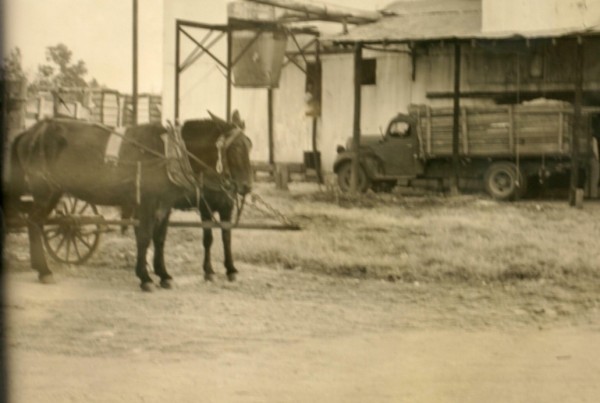
The Gin was located right
across the street from
the Wilbanks home. It was also a place to go, to explore and to
play.
It was probably crazy to play in the Gin, because many men were
probably
killed and maimed in cotton gins over the years.
The whole place was run by a big steam engine.
From this big boiler there came a huge piston that turned a large
wheel.
The wheel was used to turn a large belt. This belt was probably
two
or three feet wide, as I remember it. This belt in turn was
connected
to other wheels, which were, in turn connected to other belts, etc. to
power all the machinery in the Gin. Some of the belts were
connected different pieces
of equipment sometimes 20-50 feet away.
I used to watch the men operate the giant vacuum
that pulled the raw cotton from the cotton trailers that were pulled
under
it by trucks or tractors. This vacuum would suck the cotton out
of
the trailers into a dumper, which dropped the raw cotton, (note raw
cotton
means that the cotton seeds are still emeshed in the cotton) into a
shredder
or separator, with large wire teeth. These teeth, stuck on the
outside
of a large metal rod, rotated while the raw cotton was forced over
them.
The teeth removed the seeds from the cotton fiber. The seeds and
a lot of cotton were then dumped into a large pile, which was good for
jumping into.
The cotton was then sucked into or transported
by conveyor belt to other ginning operations until in ended up at the
"Compress".
The compress was a large steam operated contraption that turned 400-500
pounds of loose cotton fibre, into a dense rectangle of cotton
measuring
about three feet by five feet.
The cotton gin, as you might imagine was a loud
and dangerous place, with all the heavy moving equipment and belts
going
everywhere. But nothing was a loud or as dangerous as the cotton
press. The cotton was dumped a few pounds at a time into
the press, the steam would build up and the heavy steel plate would
come
down and compress the cotton into the mold. As it was compressed
it would be held in place until more loose cotton was placed under the
press and the process repeated.
A completed bale was wrapped in mesh burlap, and
kept under pressure by the use of large metal bands. These bands,
as I remember, usually two on the long end and three on the short side,
kept the compressed cotton in its small size. You must imagine
that
400 pounds of raw or fluff cotton would probably fill a room, 20 feet
long
by eight feet high, maybe more.
It was at the end of a press, that the real danger
would take place. This was when the gin compress operator would
try
to compress all of the remaining loose cotton into one very heavy bale
instead of having one light bale.
I assume, the one heavy bale, would save on the
cost of compressing one small light weight bale. This "last
bale",
was very dangerous, and I used to watch the men as they nervously
watched
the bale as the banding took place. The extreme compression of
the
cotton made this bale very dangerous to band. If the bands broke men
could
loose arms or legs or die. Missing fingers were a way of life in
the Cotton Gin.
The Auction Barn and Corrals
The Walnut livestock auction
facility was also
located across the street from the H. E. Wilbanks property. I
walked
around the area often. I remember all the cattle and horses that
were brought in and the frantic auctioneer. It was quite an
exciting
place.
© 2004-2008, by Melissa McCoy-Bell. All rights reserved.